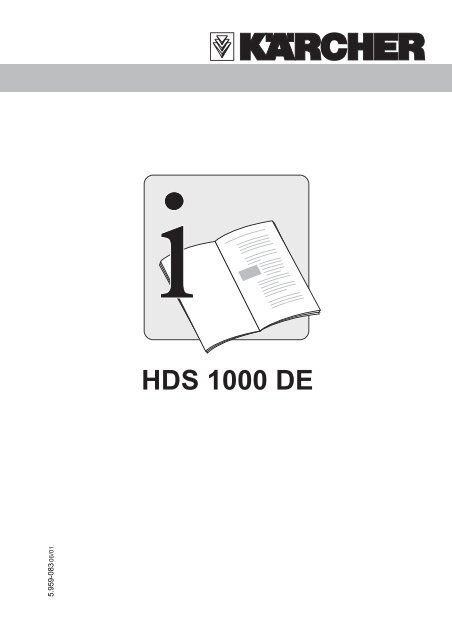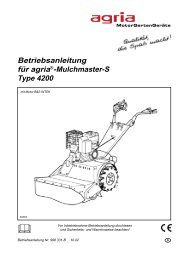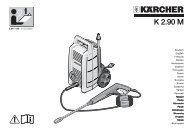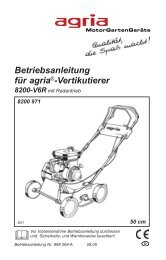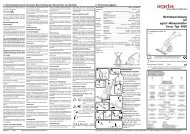HDS 1000 DE - Endress & Reiser
HDS 1000 DE - Endress & Reiser
HDS 1000 DE - Endress & Reiser
Create successful ePaper yourself
Turn your PDF publications into a flip-book with our unique Google optimized e-Paper software.
5.959-083 06/01<br />
<strong>HDS</strong> <strong>1000</strong> <strong>DE</strong>
E N G L I S H<br />
Contents<br />
I. Technical data ..................... 4<br />
II. Important notes ................... 6<br />
III. Operation ............................ 8<br />
IV. Application .......................... 9<br />
V. Care and maintenance...... 10<br />
VI. Trouble shooting................ 12<br />
VII. General Notes ................... 14<br />
VIII. Spare parts list .................. 15<br />
<strong>HDS</strong> <strong>1000</strong> <strong>DE</strong><br />
3
<strong>HDS</strong> <strong>1000</strong> <strong>DE</strong><br />
I. Technical data<br />
Engine: Yanmar L90 AE-<strong>DE</strong><br />
Air-cooled single-cylinder 4-stroke diesel engine with hand and<br />
electric start<br />
Rated power at 3600 rpm KW (Hp) 6.6 (9)<br />
Specific fuel consumption g/kWh 250<br />
Performance<br />
Operating pressure bar 40 – 200<br />
Operating pressure at steam-stage (with steam nozzle) bar < 32<br />
Max. allowable operating pressure bar 230<br />
Min. water inlet volume l/h <strong>1000</strong><br />
Flow rate l/h 450 – 900<br />
Flow rate, steam-stage l/h 450<br />
Temperature<br />
Max. feed temperature °C 30<br />
Max. working temperature, high-pressure stage °C 98<br />
Permissible working temperature, steam-stage °C 155<br />
Max. heating fuel consumption at temperature increase to 58 °C kg/h 5.56<br />
Dimensions<br />
Length mm 1100<br />
Width mm 750<br />
Height mm 785<br />
High-pressure hose, length m 15<br />
Capacities<br />
Fuel tank l 34<br />
Cleaning agent suction (infinitely adjustable) l/h 0 – 40<br />
Net weight of the machine without accessories kg 185<br />
Sound level Lpa dB (A) 93<br />
Noise level Lwa dB (A) 107<br />
4
1 Hand starter<br />
2 Electric starter<br />
3 Engine fuel tank<br />
4 Pressure gauge<br />
5 Starter battery<br />
6 High-pressure nozzle<br />
7 Spray lance<br />
8 Handgun<br />
9 High-pressure hose<br />
10 High-pressure outlet<br />
11 Burner fuel tank<br />
12 Water inlet (G 3/4")<br />
13 Adjustment wheel for pressure<br />
and flow regulation<br />
14 Pulsation damper<br />
15 Fuel pump<br />
16 Blower<br />
17 Electrical box<br />
18 Oil sight glass, pump<br />
19 Safety valve<br />
20 Burner cover<br />
21 Continuous-flow heater<br />
22 Spark-plug connector<br />
23 Sight glass<br />
<strong>HDS</strong> <strong>1000</strong> <strong>DE</strong><br />
24 Tuyere connection<br />
25 Float tank<br />
26 Container for liquid softener<br />
27 Solenoid valve, liquid softener<br />
28 Low water protection<br />
29 Filter – low water protection<br />
30 Pressure switch<br />
31 Pump for oil filler container<br />
32 High-pressure pump<br />
33 Rating plate<br />
34 Oil drain plug, engine<br />
35 Oil dip stick, engine<br />
5
<strong>HDS</strong> <strong>1000</strong> <strong>DE</strong><br />
II. Important notes<br />
Unpacking the machine<br />
– Should you find that damage has occurred during transport, inform your dealer immediately.<br />
Fitting accessories<br />
– Connect high-pressure hose to handgun and spray lance and connect to high-pressure outlet of the<br />
pump. Attach nozzle to the spray lance. Please refer to the diagram for positions.<br />
Check the oil level of the high-pressure pump<br />
– Check the oil level at the oil sight-glass. Do not put the machine into operation if the oil level has sunk<br />
below “MIN”. Top up with oil as required (see Technical Data).<br />
Engine<br />
– Before using the machine for the first time, read the operating instructions provided by the engine<br />
manufacturer and take special note of the safety instructions.<br />
– Check the oil level of the engine. Do not put the machine into operation if the oil level has sunk below<br />
“MIN”. Top up with oil as required.<br />
Care of the battery<br />
– The battery has been filled and charged at the factory. If the acid level in the battery approaches<br />
the “MIN” mark, fill with distilled water up to the “MAX” mark.<br />
Water supply<br />
Fit a water hose of at least 3/4" and connect it to the water tap. A suitable 3/4" water hose is available<br />
from Kärcher under Order no. 4.440-222.<br />
– The water supply must yield at least 16 litres per minute.<br />
– Observe the regulations of your water supply company.<br />
– The machine is fitted with a strainer at the pump inlet. Check the strainer regularly for contamination.<br />
Fuel supply<br />
Fuel tank for burner<br />
Fill the fuel tank for the burner with a light fuel oil or diesel oil.<br />
Caution!<br />
Even when operating with cold water, fill the fuel tank until the indicator light showing “fuel tank<br />
empty” goes out. Dry-running will damage the fuel pump.<br />
6
Fuel tank<br />
Fill the fuel tank for the engine with diesel.<br />
Caution!<br />
The fuel tank should not be topped up when the engine is running or hot.<br />
There is a risk of fire and explosion.<br />
Do not smoke and keep away from sparks and flames.<br />
Do not spill fuel. Wipe up spilled fuel.<br />
Always close fuel tank and fuel canister properly.<br />
Fuel vapours are poisonous; do not breathe them in.<br />
Lime-scale protection<br />
– Fill container with Kärcher scale-inhibitor fluid, Order no. 2.780-001.<br />
<strong>HDS</strong> <strong>1000</strong> <strong>DE</strong><br />
– Inquire about local hardness of water from the supply company responsible or determine it by means<br />
of a water-hardness testing kit, Order no. 6.768-004.<br />
– Install pulse generator in electrical cabinet.<br />
Water hardness 5 10 15 20 25 30<br />
Scale 10 8 7 6.5 6 5.5<br />
– Operating without lime-scale protection may cause the heating coil to become furred.<br />
Frost protection<br />
If the unit is stored without having been emptied or rinsed thoroughly with a glycol-based antifreeze at<br />
sub-zero temperatures, it will be ruined.<br />
The best form of protection from sub-zero temperatures is to place the unit and accessory (handgun,<br />
spray lance, high-pressure hose) in a covered area protected from frost.<br />
Action of the safety devices<br />
Low-water protection<br />
The low-water protection device stops the burner from switching on when there is insufficient water.<br />
When there is sufficient water supply, the float with magnet is pressed to the right and the magnet<br />
causes the reed contact to close.<br />
Only at this point can the fuel valve open. A strainer stops the low-water protection device from<br />
becoming contaminated and must be cleaned once a week.<br />
Overflow valve<br />
When the handgun is closed, the overflow valve opens and the high-pressure pump feeds the water<br />
back to the suction side of the pump. This stops the maximum permitted operating pressure from being<br />
exceeded. The overflow valve is adjusted by means of lock nuts in the factory.<br />
Safety valve<br />
The safety valve is an additional protection in the high-pressure cleaner against undue high pressure.<br />
It opens, for example, when the handgun is closed in burner mode. The safety valve is sealed.<br />
No change is allowed to be made to its setting.<br />
Pressure switch<br />
The pressure switch switches the burner off if there is a fall below the minimum operating pressure and<br />
switches on again when there is a rise above the minimum operating pressure.<br />
7
<strong>HDS</strong> <strong>1000</strong> <strong>DE</strong><br />
III. Operation<br />
1. Initial operation (cold-water mode)<br />
– Open water inlet.<br />
– Unit switch to position “SYMBOL Burner off”.<br />
– Start engine according to operating instructions.<br />
– Retract lever of handgun.<br />
The pump first extracts air out of the unit. After a short time water will come out of the nozzle.<br />
8<br />
Caution! The water jet being emitted effects a recoil force or torque on the handgun,<br />
so grip the handgun firmly.<br />
– If during operation you release the lever of the handgun, the overflow valve will open and a water<br />
circulation will take place inside the pump. At the same time, the revolutions per minute of the engine<br />
will be reduced from operating speed to idling speed by the speed regulator fitted to the cylinder head.<br />
– The switch-over pressure of approx. 240 bar remains in the system between overflow valve and<br />
handgun.<br />
– A further retraction of the lever releases this pressure, the overflow valve closes, the engine<br />
accelerates to operating speed and the spraying pressure is reasserted.<br />
2. Hot water mode<br />
– Set the temperature regulator to the desired working temperature, the maximum being 98 °C. The<br />
burner is thereby switched on. At a maximum demand on the pump, the water temperature rises in<br />
accordance with the setting on the thermostat, but not above 98 °C.<br />
3. Regulate pressure and water flow<br />
The unit is fitted with a servopress device. Operating pressure and rate of flow can be infinitely adjusted<br />
by the regulator wheel on the handgun. The temperature regulator may be set to a maximum of 98 °C.<br />
4. Steam stage mode<br />
If the temperature regulator is to be set higher than 98 °C, the nozzle on the spray lance should be<br />
exchanged for a steam nozzle.<br />
– Set the temperature regulator to 150 °C.<br />
– Set the regulator wheel on the handgun to MIN stop position.<br />
5. Spraying with cleaning agent<br />
– Hang the cleaning agent hose with filter into container of cleaning agent.<br />
– The proportion of cleaning agent in the water flow can be adjusted infinitely up to a rate of<br />
approx. 5 %.<br />
Cleaning methods<br />
a) Single-step method<br />
Spray on the cleaning agent with high pressure.<br />
b) Two-step method<br />
Spray on the cleaning agent with low pressure and leave it to take effect (1 – 5 minutes).<br />
Spray away the dirt with the high-pressure water jet (without cleaning agent).
6. Storing the unit<br />
– Set unit switch to position “Burner off”.<br />
– Set cleaning agent metering valve to “0”.<br />
– Flush unit through for at least 30 seconds.<br />
– Close handgun, the engine will adjust to idling speed.<br />
– Switch off engine.<br />
Caution! Never switch off the engine under full load with the handgun open.<br />
– Close fuel tap.<br />
– Close off water supply.<br />
– Retract lever of the handgun until no more water comes out.<br />
The unit is now without pressure.<br />
IV. Application<br />
<strong>HDS</strong> <strong>1000</strong> <strong>DE</strong><br />
The high-pressure cleaner <strong>HDS</strong> <strong>1000</strong> <strong>DE</strong> is specially designed for use where no electrical connection<br />
is available and where the work requires the use of hot water. The unit is particularly suitable for cleaning<br />
facades, machines and construction-site vehicles in the open air.<br />
Choice of operating pressure<br />
The choice of operating pressure is dependent on the cleaning task in hand. In cases of severe and<br />
encrusted dirt, the highest possible pressure should be used. For tiled walls, pressure should not exceed<br />
50 bar to avoid damaging the grouting.<br />
The operating pressure is dependent on the nozzle and is limited by the switch-off pressure of the<br />
overflow valve as indicated above.<br />
Apart from the working pressure and the distance from the object being cleaned, the form of the jet<br />
determines the effectiveness of the high-pressure jet. The 0° pencil jet has the greatest mechanical<br />
effectiveness and is used, for example, on heavily contaminated machines and parts. In normal cases<br />
a 25° nozzle is used.<br />
The high-pressure cleaner is fitted with a 25° Kärcher power nozzle at the factory. Special applications<br />
may call for the fitting of other nozzles.<br />
Order<br />
no.<br />
Nozzle<br />
type<br />
Spray<br />
angle<br />
Pressure<br />
bar<br />
5.765-032 00050 0 °C 200 50<br />
2.883-399 25050 25 °C 200 50<br />
Recoil<br />
force N<br />
Cleaning agent<br />
In accordance with the guidelines laid down for liquid jet cleaners, § 5.4, the only cleaning agents<br />
permitted are those to which the manufacturer of the unit gives approval.<br />
We recommend the use of Kärcher cleaning agents. Unsuitable cleaning agents can damage the highpressure<br />
cleaner and the object which is to be cleaned.<br />
– For further information, please ask for product-specific documentation on the cleaning and care<br />
products range.<br />
– Please note the instructions for use on the label of the drum and in the product information sheets.<br />
9
<strong>HDS</strong> <strong>1000</strong> <strong>DE</strong><br />
V. Care and maintenance<br />
Care and maintenance work forms part of the responsibility of the operator. It must be carried out<br />
with care and precision in order to maintain the operational efficiency of the unit.<br />
a) Engine: Maintenance in accordance with the engine<br />
manufacturer’s operating instruction manual<br />
b) High-pressure cleaner<br />
1. Maintenance Schedule:<br />
weekly Oil level: if the oil is milky or if the oil-level has fallen below the “MIN” mark,<br />
change the oil or top it up (see V.2.) as the case may be.<br />
Clean filter of the low-water protection device.<br />
monthly Remove tuyere connection and clean ignition electrodes or adjust<br />
electrode gap.<br />
half-yearly or as<br />
necessary<br />
2. Oil change<br />
– Drain off oil at the drain plug into a collecting tray.<br />
– Fasten drain plug again.<br />
– Fill with oil up to the “MAX” mark.<br />
– Oil type: Hypoid oil SAE 15 W/40. (Order no. 6.288-050, 1 litre)<br />
3. Decarbonising the heating coil<br />
Undo all connections to the boiler cover (cloth seal, spark-plug connector, fuel line, fastening<br />
screws). The boiler is entirely disassembled and the heating coil dismantled. The heating coil can<br />
then be cleaned (e.g. with a second unit).<br />
10<br />
Empty and clean burner fuel tank.<br />
Clean filter before burner fuel pump and fuel nozzle.<br />
Remove sulphur and carbon from heating coil (see V.3.).<br />
Oil change (see V.2.).
<strong>HDS</strong> <strong>1000</strong> <strong>DE</strong><br />
4. Removal of internal deposits<br />
If there are internal deposits in the pipe lines, the flow resistance increases with the result that the<br />
overflow protection can switch over.<br />
According to legal regulations, only boiler cleansing compounds which have certification marks can be<br />
used to remove the deposits:<br />
RM 100 6.287-008 dissolves limestone and simple compounds consisting of limestone<br />
and detergent residues.<br />
RM 101 6.287-013 dissolves deposits which cannot be dissolved with RM 100.<br />
Procedure<br />
Caution! The gases that are given off are combustible.<br />
Do not smoke and provide good ventilation.<br />
– Fill a 20-litre container 3/4 full of water.<br />
– Add one litre of boiler-cleansing compound to the 15 litres of water.<br />
– Connect water hose direct to the pump head and hang the free end in the container.<br />
– Connect the spray lance without nozzle and insert in the container.<br />
– Switch unit switch to “Burner on”, until approx. 40 °C has been reached.<br />
– Turn off unit and let it stand for 20 minutes.<br />
– Then pump the unit until empty.<br />
Caution: When the descaling process is in action, the handgun must always remain pressed.<br />
– To conclude, we recommend the use of an alkaline solution (e.g. RM 81) to be pumped through the<br />
unit via the detergent tank to provide protection against corrosion and to neutralise the acid residue.<br />
5. Repairs<br />
The safety valve is adjusted and sealed in the factory; it may not be changed. Checking of the overflow<br />
valve and safety valve should be carried out only by a specialist technician.<br />
6. High-pressure hoses<br />
Devote special attention to the hoses. Every high-pressure hose must accord with the safety<br />
regulations and must be marked with the maximum permitted operating pressure, the manufacturer’s<br />
set date for usage and the manufacturer.<br />
High-pressure hoses may not be kinked, stretched, crushed or damaged in any other way. Damaged<br />
high-pressure hoses are in danger of bursting and must be replaced without delay.<br />
High-pressure hoses of short service life and those which are not repaired properly are extraordinarily<br />
dangerous. Therefore use only certificated and marked high-pressure hoses.<br />
Kärcher original high-pressure hoses meet the safety requirements.<br />
7. Notes on the fuel pump for the burner<br />
Even when the unit is running in cold-water mode, it must not be allowed to operated without fuel oil or<br />
diesel in the fuel tank, otherwise there is a danger that the fuel pump will dry-run and in consequence<br />
the drive clutch and fuel pump will be destroyed.<br />
11
<strong>HDS</strong> <strong>1000</strong> <strong>DE</strong><br />
VI. Trouble shooting<br />
Fault Cause Remedy<br />
1. Engine does not run a) Fuel tank empty<br />
Check, fill up.<br />
2. Unit does not come<br />
up to pressure<br />
3. Burner does not<br />
ignite or flame goes<br />
out whilst unit in<br />
operation<br />
12<br />
b)<br />
c)<br />
a)<br />
b)<br />
c)<br />
d)<br />
e)<br />
f)<br />
g)<br />
h)<br />
i)<br />
k)<br />
a)<br />
b)<br />
c)<br />
d)<br />
e)<br />
f)<br />
g)<br />
Spark plug<br />
Other causes<br />
Pump is sucking in air<br />
Strainer at pump inlet blocked<br />
Pump has not been bled<br />
Pump or overflow valve defective<br />
Safety valve out of adjustment<br />
Insufficient water supply<br />
Cleaning agent valve leaking,<br />
cleaning agent pump sucks in air<br />
Strainer in front of low water<br />
protection device dirty<br />
Safety valve leaking<br />
Cleaning agent container empty<br />
No ignition spark (can be<br />
ascertained through sight glass<br />
in burner cover)<br />
Burner fuel tank empty<br />
Fuel filter blocked<br />
Insufficient sputtering of the burner<br />
nozzle<br />
Fuel pump or coupling defective<br />
Low water protection device does<br />
not operate<br />
Thermostat defective or set too low<br />
See operating instructions, engine<br />
See operating instructions, engine<br />
Check water hose<br />
Open water inlet<br />
Clean strainer<br />
Switch off unit, retract handgun<br />
lever, switch on unit with opened<br />
handgun, if necessary repeat<br />
procedure.<br />
Call in Customer Service<br />
Call in Customer Service<br />
Open water tap<br />
Check and seal<br />
Dismantle strainer and clean it<br />
Call in Customer Service<br />
Fill up cleaning agent container or<br />
set cleaning agent valve to “0”.<br />
Clean electrode and adjust electrode<br />
gap. Check ignition transformer and<br />
spark-plug connector.<br />
Top up<br />
Dismantle and clean<br />
Dismantle filter and clean it<br />
Disassemble and replace damaged<br />
parts.<br />
Water supply not sufficient.<br />
Reed switch or magnetic pistons<br />
defective.<br />
Replace or set higher
Fault Cause Remedy<br />
4. Water jet uneven a)<br />
5. No suction of<br />
cleaning agent<br />
6. Flow protection<br />
does not switch on<br />
– no flame<br />
b)<br />
a)<br />
b)<br />
a)<br />
b)<br />
c)<br />
d)<br />
e)<br />
Nozzle blocked<br />
Safety valve out of adjustment<br />
Cleaning agent filter blocked or<br />
container empty<br />
Cleaning agent hoses, cleaning<br />
agent metering valve leaking or<br />
blocked.<br />
Water supply valve closed<br />
Insufficient water<br />
Strainer in front of flow protection<br />
blocked<br />
Valves in the high-pressure pump<br />
leaking or dirty<br />
Water pressure too low<br />
<strong>HDS</strong> <strong>1000</strong> <strong>DE</strong><br />
Blow nozzle through with<br />
compressed air. If necessary clean<br />
with a pin or similar.<br />
Call in Customer Service<br />
Clean or fill up<br />
Check and clean<br />
Open it<br />
Provide for adequate water supply<br />
Check, dismantle strainer and clean<br />
Check valve plates and seatings,<br />
if necessary replace.<br />
Remedy problem<br />
7. Oil looks milky-white a) Leaking seal Call in Customer Service<br />
13
<strong>HDS</strong> <strong>1000</strong> <strong>DE</strong><br />
VII. General Notes<br />
1. System test pressure and design accord with the statutory regulations for steam boilers.<br />
2. The “Richtlinien für Flüssigkeitsstrahler” (Guidelines for liquid jets) issued by the Verband der<br />
gewerblichen Berufsgenossenschaften, available from Carl Heymanns-Verlag KG, Luxemburger<br />
Str. 449, 5000 Köln 41, apply in the Federal Republic of Germany.<br />
3. In accordance with the “Richtlinien der Flüssigkeitsstrahler” (paragraph VI.1.), high-pressure jets<br />
must be inspected at least every 12 months by an expert; the results of the inspection must be put<br />
in writing.<br />
Kärcher Customer Service maintenance engineers are experts and can carry out this prescribed<br />
inspection at your premises.<br />
4. The volume of water in the unit amounts to less than 10 litres. The unit is therefore subject to no<br />
installation regulations as far as the boiler is concerned. When operating with temperatures of over<br />
100 °C in unsupervised operation, the burner must be fitted with a flame monitoring system.<br />
Regulations of the local building authorities should be observed.<br />
5. The heating facility is a furnace which, according to the first ordinance for the implementation of the<br />
Federal law on the protection against noxious emissions, must be checked once a year for its<br />
adherence to emission control values by your area chimney sweep responsible for such tasks. The<br />
operator of the high-pressure cleaner must arrange for the measurement to take place.<br />
6. Safety inspection agreement<br />
You can enter into a safety inspection agreement with Kärcher. This includes the inspection with<br />
inspection badge and inspection record as required under VII.3. and VII.5.<br />
7. Maintenance agreement<br />
You can also enter into a maintenance agreement with Kärcher. It involves all the care and<br />
maintenance operations as in V.1. Maintenance Schedule. The maintenance agreement contains in<br />
it the safety inspection agreement.<br />
8. Accessories<br />
Wrong, unsuitable or defective accessories impair the functioning of your Kärcher unit. Their use is<br />
dangerous. Ask us or your dealer about suitable and tested accessories. A Kärcher original<br />
accessory is practical and tailor-made.<br />
9. Spare parts<br />
Be aware that the use of other than original spare parts can lead to the occurrence of faults and also<br />
to bad accidents when these parts have not been manufactured properly, or when they do not exactly<br />
replace the original part. They can also make the operation of the unit unreliable.<br />
Original spare parts offer the guarantee that you will always be able to operate your unit safely and<br />
free of faults.<br />
You will find the numbers of a selection of the most commonly required replacement parts on the back<br />
cover.<br />
14
<strong>HDS</strong> <strong>1000</strong> <strong>DE</strong><br />
1.811-936.0<br />
5.063-664.0<br />
5.731-039.0<br />
5.321-177.0<br />
7.307-181.0<br />
5.132-010.0<br />
5.132-010.0<br />
7.305-023.0<br />
5.045-211.0<br />
5.321-023.0<br />
4.820-946.0<br />
4.760-355.0<br />
5.363-300.0<br />
6.303-025.0<br />
6.654-074.0<br />
6.654-026.0<br />
2.880-296.0<br />
5.401-210.0<br />
5.321-493.0<br />
5.826-020.0<br />
6.654-075.0<br />
4.820-732.0<br />
5.321-493.0<br />
4.760-355.0<br />
5.826-020.0<br />
4.775-254.0<br />
5.042-252.0<br />
6.491-261.0<br />
6.491-262.0<br />
5.042-402.0<br />
2.880-296.0<br />
6.390-185.0<br />
6.362-422.0<br />
6.390-185.0<br />
6.390-185.0<br />
10.12.1999


